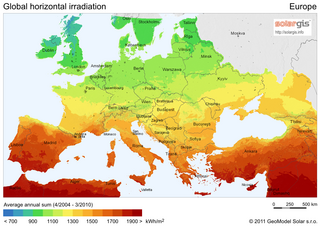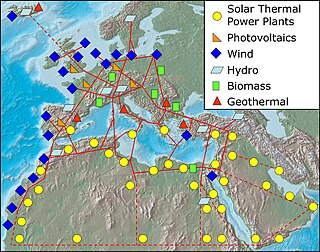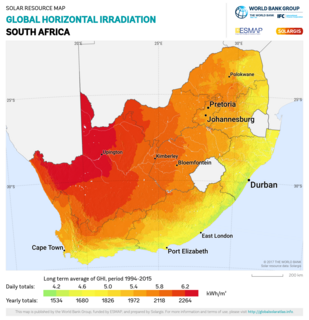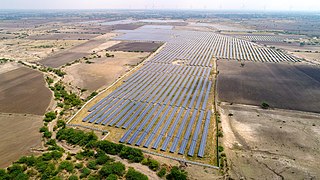
Renewable energy plays an important and growing role in the energy system of the European Union. The share of energy from renewable sources in gross final consumption of energy was 18% in 2018. This is double the share in 2004 with 8.5%. The Europe 2020 strategy includes a target of reaching 20% of gross final energy consumption from renewable sources by 2020, and at least 32% by 2030. These figures are based on energy use in all its forms across all three main sectors, the heating and cooling sector, the electricity sector and the transport sector.

Many countries and territories have installed significant solar power capacity into their electrical grids to supplement or provide an alternative to conventional energy sources. Solar power plants use one of two technologies:

Solar power in Germany consists almost exclusively of photovoltaics (PV) and accounted for an estimated 8.2 percent of the country's gross-electricity generation in 2019. About 1.5 million photovoltaic systems were installed around the country in 2014, ranging from small rooftop systems, to medium commercial and large utility-scale solar parks. Germany's largest solar farms are located in Meuro, Neuhardenberg, and Templin with capacities over 100 MW.

Solar power represented a very small part of electricity production in the United Kingdom (UK) until the 2010s when it increased rapidly, thanks to feed-in tariff (FIT) subsidies and the falling cost of photovoltaic (PV) panels.

Solar power is the conversion of renewable energy from sunlight into electricity, either directly using photovoltaics (PV), indirectly using concentrated solar power, or a combination. Concentrated solar power systems use lenses or mirrors and solar tracking systems to focus a large area of sunlight into a small beam. Photovoltaic cells convert light into an electric current using the photovoltaic effect.

Solar power in the European Union consists of photovoltaics (PV) and solar thermal energy.
DESERTEC is a foundation that is promoting the production of renewable energy in deserts. The project aims at creating a global renewable energy plan based on the concept of harnessing sustainable power from sites where renewable sources of energy are more abundant and transferring it through high-voltage direct current transmission to consumption centers. With new innovations and a rising demand from indstustries, like the steel sector, the foundation also works on concepts involving green hydrogen. All kinds of renewable energy sources are envisioned, but the sun-rich deserts of the world play a special role.

Concentrated solar power systems generate solar power by using mirrors or lenses to concentrate a large area of sunlight onto a receiver. Electricity is generated when the concentrated light is converted to heat, which drives a heat engine connected to an electrical power generator or powers a thermochemical reaction.

Solar power in California includes utility-scale solar power plants as well as local distributed generation, mostly from rooftop photovoltaics. It has been growing rapidly because of high insolation, community support, declining solar costs, and a Renewable Portfolio Standard which requires that 33% of California's electricity come from renewable resources by 2020, and 60% by 2030. Much of this is expected to come from solar power via photovoltaic facilities or concentrated solar power facilities.

The European super grid is a possible future super grid that would ultimately interconnect the various European countries and the regions around Europe's borders – including North Africa, Kazakhstan, and Turkey – with a high-voltage direct current (HVDC) power grid.
Renewable energy in Morocco represented 0.4% of the national energy balance and nearly 10% of electricity production in 2007. Renewable energy is supported by strong hydropower sources and the newly installed wind energy parks. Morocco plans a $13 billion expansion of wind, solar and hydroelectric power generation capacity and associated infrastructure that should see the country get 42% of its electricity from renewable sources by 2020. The Moroccan government is keen on increasing renewable energy production, as Morocco's January–September oil bill reached about US$1.4 billion in subsidies in 2009, registering a fall of 57.9% compared to 2008.
Medgrid project, created at the end of 2010 in Paris, is a large industrial project planned in North Africa, which aims to promote and develop a Euro-Mediterranean electricity network that would provide North Africa & Europe with inexpensive renewable electricity, mostly from solar. The goal is to install 20 gigawatts (GW) of generating capacity, with 5 GW being devoted for exports to Europe.

Solar power in South Africa includes photovoltaics (PV) as well as concentrated solar power (CSP). In 2016, South Africa had 1,329 MW of installed solar power capacity. Installed capacity is expected to reach 8,400 MW by 2030.

Solar power in Morocco is enabled by the country having one of the highest rates of solar insolation among other countries— about 3,000 hours per year of sunshine but up to 3,600 hours in the desert. Morocco has launched one of the world’s largest solar energy projects costing an estimated $9 billion. The aim of the project is to create 2,000 megawatts of solar generation capacity by the year 2020. Five solar power stations are to be constructed, including both photovoltaic and concentrated solar power technology. The Moroccan Agency for Solar Energy (MASEN), a public-private venture, has been established to lead the project. The first plant will be commissioned in 2015, and the entire project in 2020. Once completed, the solar project will provide 38% of Morocco’s annual electricity generation.

Africa is often considered and referred as the "Sun continent" or the continent where the Sun's influence is the greatest. According to the "World Sunshine Map", Africa receives many more hours of bright sunshine during the course of the year than any other continent of the Earth: many of the sunniest places on the planet lie there.
Under its commitment to the EU renewable energy directive of 2009, France has a target of producing 23% of its total energy needs from renewable energy by 2020. This figure breaks down to renewable energy providing 33% of energy used in the heating and cooling sector, 27% of the electricity sector and 10.5% in the transport sector. By the end of 2014, 14.3% of France's total energy requirements came from renewable energy, a rise from 9.6% in 2005.

Karnataka I solar park is a 40.5 megawatt (MWDC) photovoltaic power station. It is located at Chikkoppa Village in the Koppal District of the Indian state of Karnataka. It was commissioned in January 2018. It covers 178 acres and supplies about 72,000 people with energy. The solar park is operated by Talettutayi Solar Projects One Private Limited and was constructed using 125,080 solar modules. The solar power from the plant is taken by Solar Energy Corporation of India (SECI).












